The Simplified Guide to a Modern Sales Strategy
Table of Contents
Jump to your desired section

Every organization needs a comprehensive sales strategy. Defining your sales strategy is the first step to ensuring that you reach your revenue goals. A successful strategy hinges on your ability to develop the right approaches to engage prospects and convert them to customers. A solid sales strategy will empower your entire company to foster meaningful relationships that increase conversion and retention rates.
Section 1: What’s in a Sales Strategy?

Every sales organization should have a written sales strategy plan summarizing its key performance indicators (KPIs), goals, processes, and more. This comprehensive selling plan is typically developed by sales or revenue leaders to help the company hit revenue targets and increase profits.
Every business is unique. The types of sales strategies each company employs is contingent on its individual needs. Most businesses develop a plan that includes a variety of approaches.
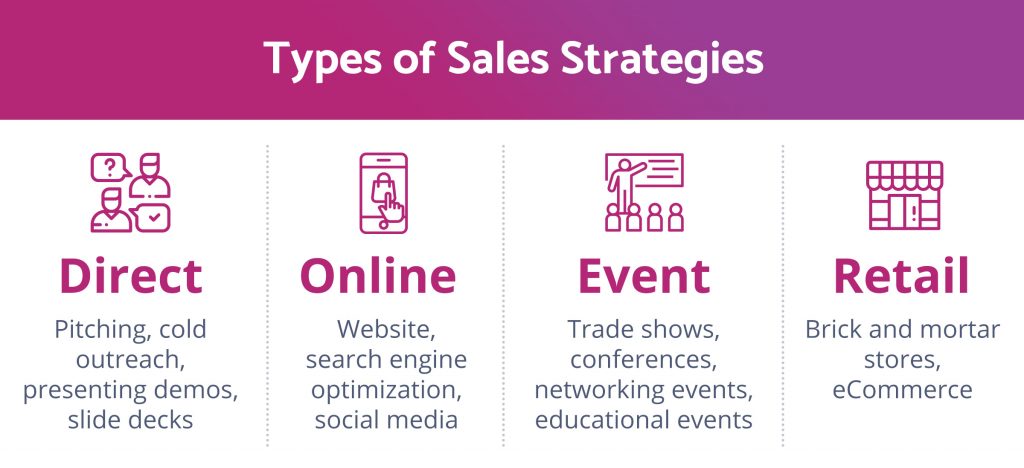
Target Audience
Your sales strategy will vary, depending on your industry. For instance, a business that sells to consumers will have a vastly different strategy than a business that sells to other businesses. No matter what industry you’re in though, you need to first identify your target market.
This can include basic demographics like gender, age, marital status and income; business data like industry, company size, revenue; geographic location; interests and more.
KPIs and Analytics
Data is a powerful guide for most decisions sales leaders must make. Businesses should establish a method to track KPIs and analytics to accurately measure sales performance, revenue generated, sales cycle length, and more. Performance metrics help teams set and track benchmarks and milestones and unify efforts around a centralized goal. They also enable teams identify and optimize sales tactics that aren’t helping them reach their defined goals.
Outreach Channels
Many businesses employ a variety of tactics and channels to reach prospective buyers. Will you contact prospects via digital channels (email, social media, display advertising, etc.)? What about more traditional approaches like face-to-face sales or telemarketing?
Competitive Analysis
Every successful sales strategy is constructed with awareness to the competition. Understanding the methods your competitors are employing will enable you to improve your own tactics.

Market Trends
Financial markets and consumer behaviors are continuously evolving. The best sales strategies analyze and predict these shifts in market and are nimble enough to adjust course when necessary.
Sales Organization
Sales strategies must include processes for growing sales teams and managing performance. Sales reps job descriptions, commission, and compensation should all be considered when building out your sales action plan. You also need to map out team structure, sales territories, opportunity routing rules.
Section 2: Inbound Sales Methodology vs. Outbound Sales Methodology

Inbound and outbound are the two most common sales approaches. Simply defined, inbound sales are leads that come to you. Conversely, outbound sales are prospects you pursue. Both inbound and outbound tactics are vital and should be used in tandem to help an organization meet its sales goals. Approaching the market with multiple methodologies will increase your organization’s chances of hitting revenue goals.
Inbound Sales Methodology
Inbound sales is a sales methodology whereby an organization engages with prospects through targeted digital channels. Tactics are designed to guide prospects through all stages of the funnel from top-of-funnel awareness through the decision-making process. Common inbound digital marketing tactics include search engine optimization, social media, and content marketing activities.

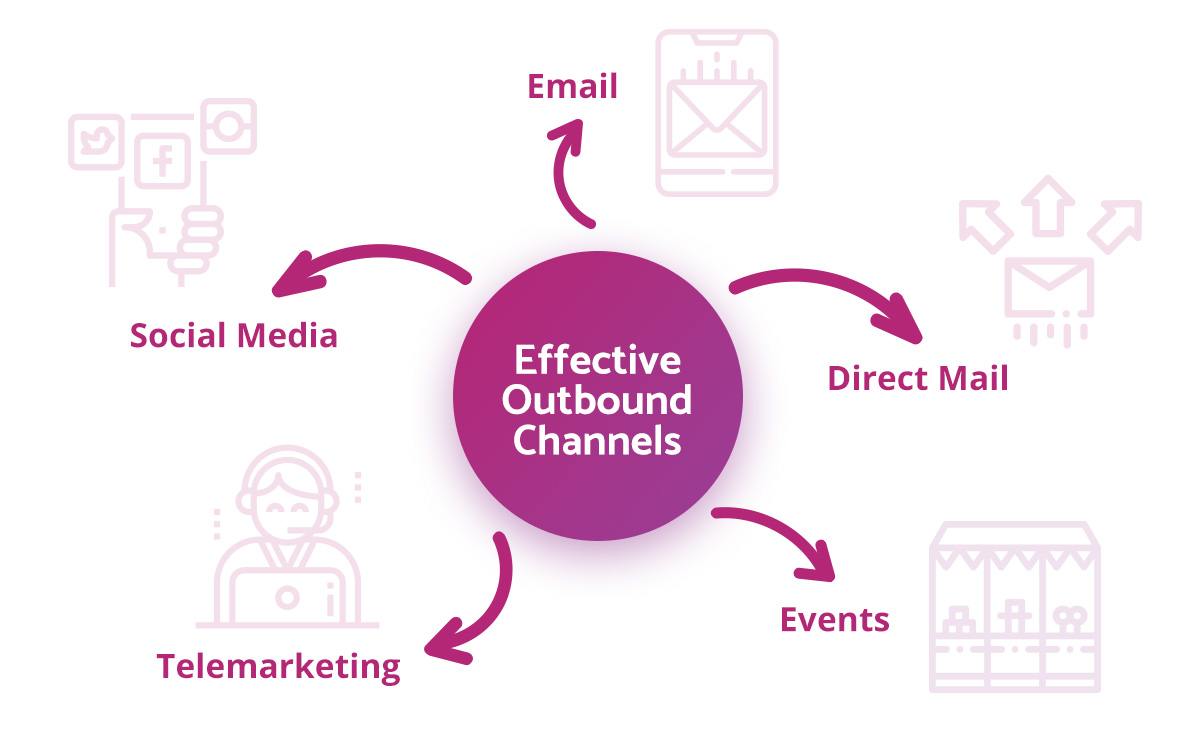
Outbound Sales Methodology
Outbound sales is a sales methodology where sales reps connect with prospects to create relationships, earn trust, and win business. Prospects’ first interaction with a brand is typically when they’re contacted by a sales rep via an outbound sales channel. Sales reps engage with prospects via phone, email, social media and face-to-face interactions to educate them about solutions and/or products.
For years, people have been predicting the end of outbound sales strategies amid the mounting adoption of inbound strategies. But outbound sales strategies are still alive and well. Outbound tactics are still extremely vital to many organizations. In fact, 55% of leads generated come from outbound sales. And inbound? 27%. So why is outbound still more effective? Simply put, businesses cannot expect customers to fall into their lap and convert into paying customers.
Section 3: Common Reasons Sales Organizations Fail

There are many external factors that limit a sales department from growing: industry performance, market demand, and consumer preferences to name a few. So what are the internal factors that prevent a sales organization from success?
An undefined sales framework
Determining how an organization is structured is instrumental to your sales team’s success. How are accounts disseminated to the team? Unorganized processes and misalignment across teams leads to duplicated efforts, lengthy hand-off times, and damaged relationships between teams. Building a solid sales framework brings more transparency to salespeople on the processes they must use to help the company meet its goals.
Ineffective onboarding and training
Companies with formal employee onboarding programs have significantly greater profits and employee retention, productivity, and satisfaction. Employee trust and performance also improve. Therefore, it’s critical that companies implement a solid employee onboarding program that sets proper expectations from day one. But training shouldn’t stop after the first few months on the job. Sales reps should also receive proper training for continued growth and development.
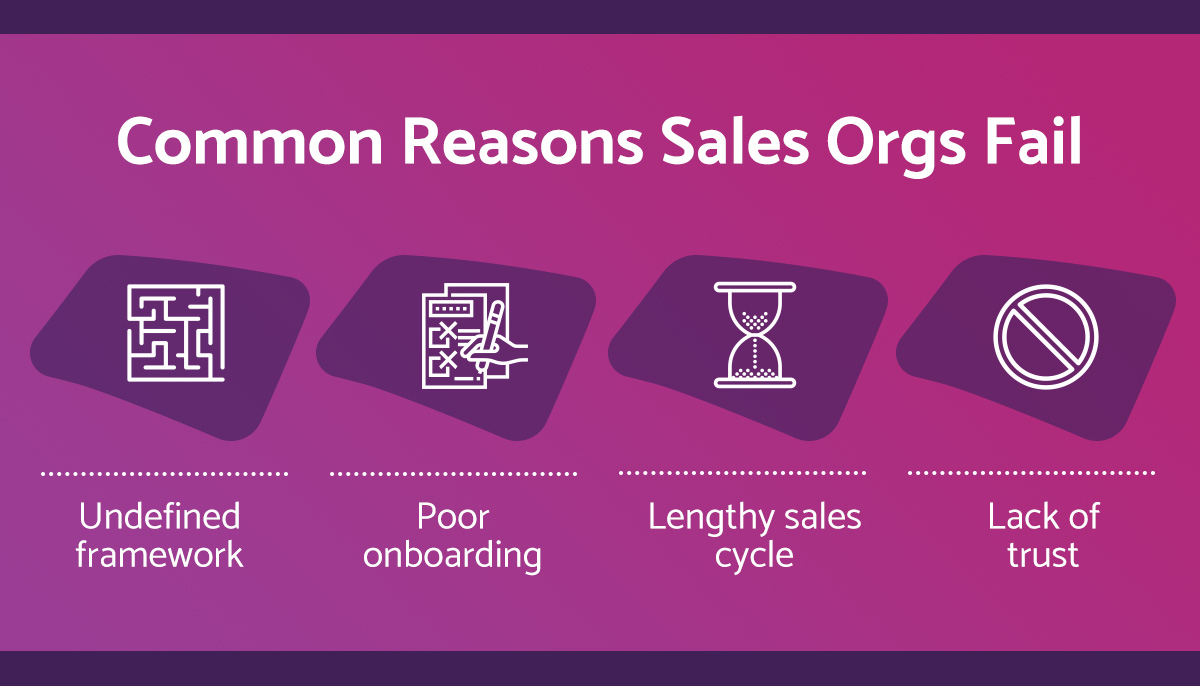
Lengthy sales cycles
Prolonged sales cycles will kill any organization’s bottom line. Luckily there are steps that sales organizations can take to shorten the buying process. The first step is truly understanding target audiences and their pain points, desires, and reservations. The sales cycle can also be optimized by implementing proper sales tools that reduce sales reps’ workloads.
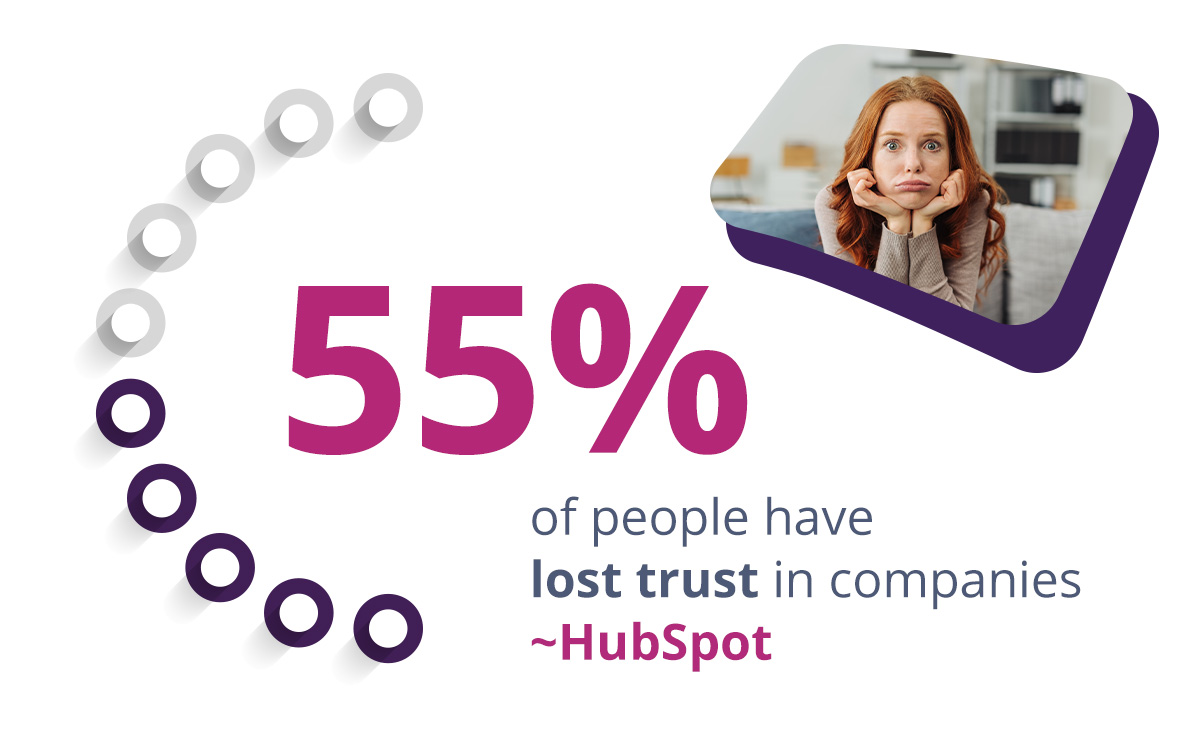
Lack of consumer trust
According to HubSpot’s 2018 Research Trust Survey, consumers are less likely to trust what salespeople say than they were 20 years ago. In fact, 55% of Hubspot’s respondents said they didn’t trust the companies they purchase from as much as they used to. Increasing customer trust will improve customer retention and word of mouth promotion. Gain trust with consumers by delivering quality products or services, improving customer service channels, and building solid customer onboarding programs.
Section 4: Sales Planning

1. Get Smart About Sales Goals
Setting goals is critical to achieving sales success. Goals keep teams centrally motivated, hold sales departments accountable, and help you measure performance. Many organizations employ “SMART” key performance indicators to measure their success and ensure sales goals are realistic and attainable. “SMART” goals are Specific, Measurable, Attainable, Relevant, and Timely.
- Specific – Specific goals are clear and accurate. Your goal should answer the five “W” questions: what, why, who, where, when.
- Measurable – Measurable goals set concrete criteria to attain your goal. Increasing sales revenue by 15 percent in Q1 is an example of a measurable goal.
- Attainable – Avoid setting goals that are impossible to achieve. Instead, set goals that are reasonable and attainable.
- Relevant – Does your goal align with your company’s overall mission? If not, you’ll want to find a new goal to set.
- Timely – All sales goals should be time-sensitive. Will your objective be completed in the next month, quarter, or year? Setting a due date will make it easier to measure sales performance.
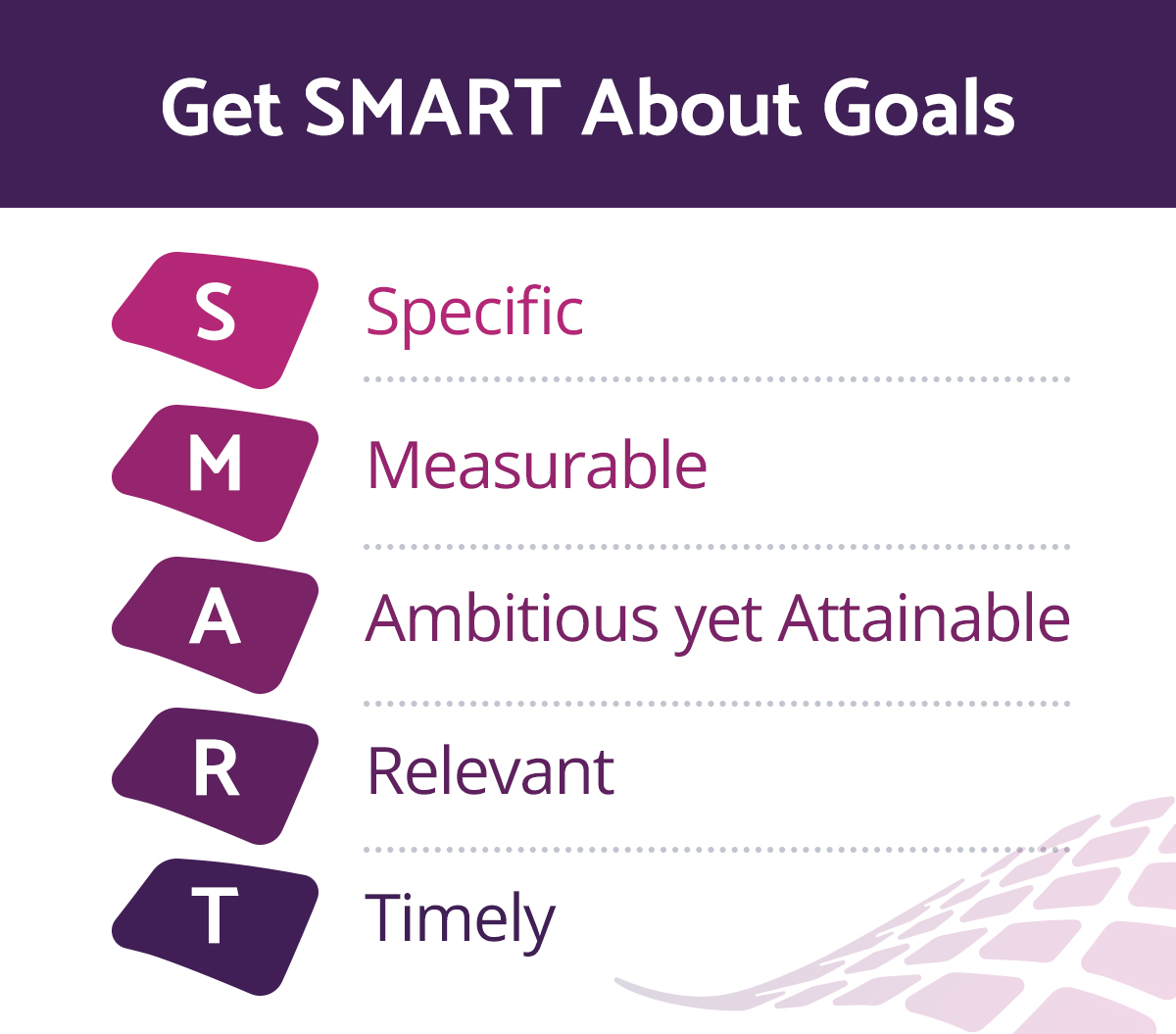
Step 2: Build Buyer Personas
Buyer personas (or marketing personas) are fictitious, broad descriptions of your ideal customers. Sales, marketing, customer success, and product teams use buyer personas to attract, engage, and humanize the buying journey for prospects and customers. Additionally, in today’s landscape consumers expect a personalized experience. In fact, more than 50% of consumers expect companies to personalize offers and communications. This belief is even higher with millennial consumers.

It’s important to build your buyer personas as if they were actual people. This will enable you to create marketing and sales messaging that better fits their needs, wants, and desires. From Manager Maggie to Soccer Mom Sam, deep insight into your buyer persona(s) is a valuable tool that fuels marketing communications and sales outreach activities.
You may have a simplified view of your target buyers. For instance, your buyers might be IT management professions. However, do you know their pain points or what drives them to find a solution? Building comprehensive buyer personas will help you understand your ideal customers on a deeper level. The number of buyer personas you develop is dependent on your business. Some businesses have one to two, and some have as many as 20.
Here’s a simple process that you can use to create buyer personas:
Do audience research
Learn about your existing customers: Utilize your customer retention management (CRM) software to reveal generalizations between leads and customers. Demographic details like job title, industry, and company size are all characteristics to look for. Detail what the typical prospect journey looks like and how you can recreate that in the future. Obviously not all customers will be an exact match to these criteria, however this exercise will help eliminate wasted hours chasing prospects who aren’t likely to purchase.
Capture persona information on your website
Use website lead forms to capture demographic or firmographic information. For instance, if your personas vary based on industry, ask each lead for information about their industry on your forms.
Identify pain points, goals, and challenges
What challenges are potential customers attempting to solve? What are their motivations, desires, and reservations? Uncover what customers like about your product and services by conducting surveys in person, over the phone, or via email. You can also interview salespeople and customer service reps to understand the prospects and customers they commonly interact with. What commonalities can they make about your top-performing customers? What about underperforming customers?
Establish how your brand can help
Once you understand the challenges and aspirations of customers, it’s time to distinguish how your products or services can help them. What benefits do customers get from using your products or services? It’s important to walk a mile in the customers’ shoes to really understand their perspective.

Step 3: Analyze Industry performance
Conducting a thorough industry analysis will help you determine how your industry is performing. It will also help you forecast future industry trends. Additionally, you can conduct a S.W.O.T. analysis to determine strengths, weaknesses, opportunities, and threats and how you rank up in comparison with the competition. Start by analyzing the demand and supply chain of your industry.
Here are a few important questions to answer:
- How has the industry performed in the past?
- What is the future viability of the industry?
- What is your current percentage of market share? How can you improve?
- What operational efficiencies do you hold that your competitors do not?
- How can you remain competitive in the industry?
Step 4: Define Key-Value Proposition
A value proposition should answer why someone would purchase your products or services over your competitors. It should persuade prospects that your products or services will provide more value to them over similar products or services in the market. A great value proposition should:
- Be clear and easy to understand
- Define your brand’s visual identity, voice and messaging
- Answer what problems and pain points your product or services solve for
- Detail the benefits of using your company’s product or services over your competitors
- Be consistently displayed across your website and customer touchpoints
Step 5: Determine your Competitive Advantages
A competitive advantage is a benefit that your products or services provide to consumers that they cannot receive from competing companies. To determine your competitive advantage, identify something opposing companies cannot easily copy. This could be location, price, operational processes, convenience, and more. Start by researching the differences between your goods and services and your competitor’s. What are your comparative strengths? What are your weaknesses? How are your company’s product or services unique?
Step 6: Set Metrics and Benchmarks

Benchmarking is the process of comparing a businesses’ performance metrics with the top performers in their industry. Quality of services, time to purchase, and cost are all typically measured. Simply put, creating benchmarks will help your company establish what metrics you must reach to be successful in your industry. Benchmarks will also enable you to determine what quotas you need to reach to increase your percentage of market share. From there, you can build data-centric goals and objectives.
Here are some important metrics to track:
- Growth: How well a company builds revenue over a specific time period.
- Sales Target: Overarching business objectives versus actual campaign performance.
- Revenue: The money a business earned from the sale of their products or services.
- Opportunities: A verified prospect who has been qualified by marketing and sales.
- Sales to Date: The total sales over the past year.
- Monthly Sales: The total sales over the past month.
- Product Performance: The sales of a specific product or product line.
- Lead Conversion Rate: The amount of leads that convert to sales opportunities.
- Sell Through Rate: The measurement of sales compared to an entire inventory.
- Average Purchase Value: The average value of each customer purchase.
- Sales by Region: Regional variations in sales and profits.
Step 7: Listen to Your Audience
Listening to your audience is vital to analyzing your performance and determining areas in your pre- and post-buying experience that can be improved. The first step is ensuring that your customers have a simple way to send feedback. Social media channels, website chat bots, customer service emails, and contact us forms are all great contact methods. Not only will you want to ensure you have several feedback channels enabled, but you’ll also want to regularly seek out feedback from customers.
Section 5: Customer Acquisition Strategies

Customer acquisition is the combined methods, processes, and strategies a business performs to encourage potential customers or clients to purchase. Simply defined, customer acquisition is everything your business does to persuade someone to purchase. Customers are the lifeblood of any organization, and therefore, all businesses need to continuously hone their customer acquisition strategies to keep sales pipelines full.
It can be time-consuming, difficult, and costly to convert prospects into customers. And it’s only getting harder. According to Hubspot, 40% of salespeople think it’s more difficult to get a prospect to respond today than it was in the past. Smart businesses are always on the lookout for new tactics to improve acquisition processes while lowering costs. Customer acquisition strategies and channels fluctuate with time and your business must have flexible processes in place to evolve with consumer demand.
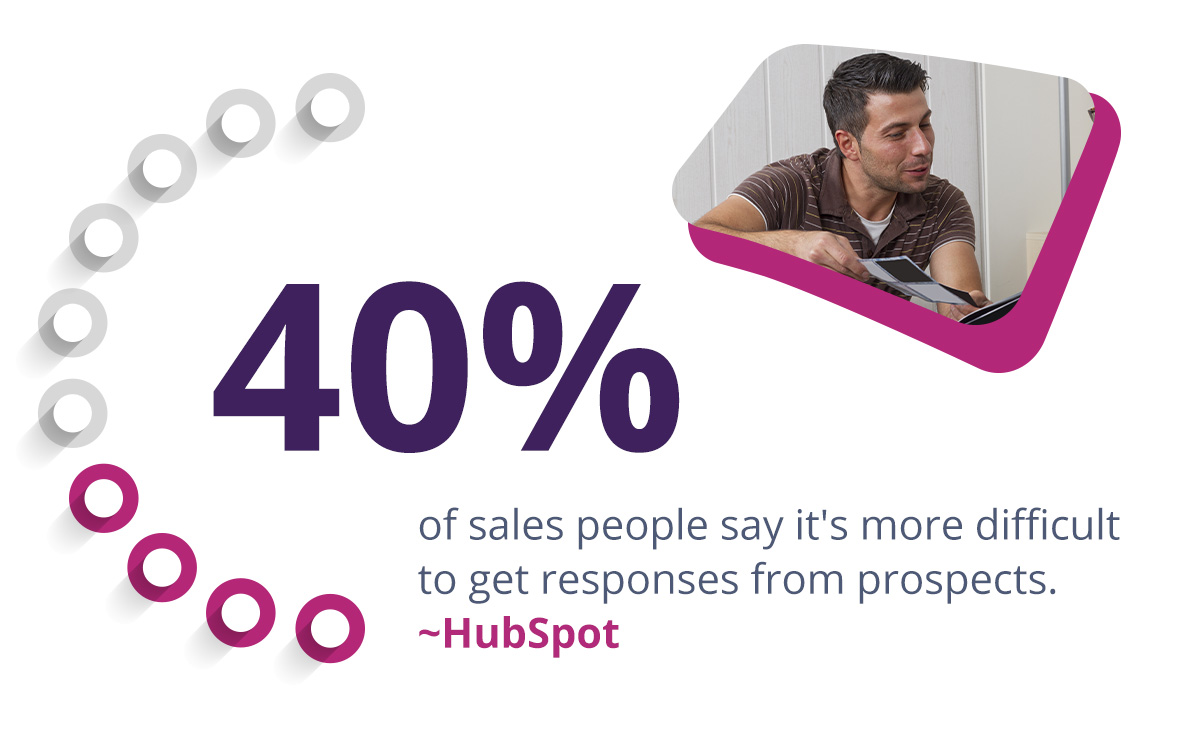
Convincing a potential customer to purchase takes a variety of marketing and sales tactics. Having a defined, written strategy will enable your organization to hit sales benchmarks, reinvest profits in growth and development, and keep business operations afloat.
There are several tactics we recommend considering including in your customer acquisition strategy.
Communicate with your ideal buyer
After you have defined a target audience or audiences, you can create messaging that specifically targets their pain points, wants, and needs. After all, your marketing and sales efforts won’t attract and engage with the right audience if you’re not creating messaging that ideal buyer cares about. Additionally, you’ll avoid spending advertising and marketing budgets on buyers who are not in the market for your products or services.
Determine customer acquisition cost
Customer acquisition costs, also known as CAC, are all of the accumulated costs a business incurs while persuading prospects to purchase from them. Everything from advertising, marketing, research and development, and sales costs are all CACs. Customer acquisition costs have risen by more than 50% over the last five years. Therefore, many businesses are determined to develop strategies to lower their acquisition cost.
CAC can be calculated by campaign or by a specific time period (month, quarter, year, etc.). Many businesses measure CAC to understand the ROI of specific campaigns. From there they are able to determine the impact of marketing and sales efforts and optimize future campaigns.
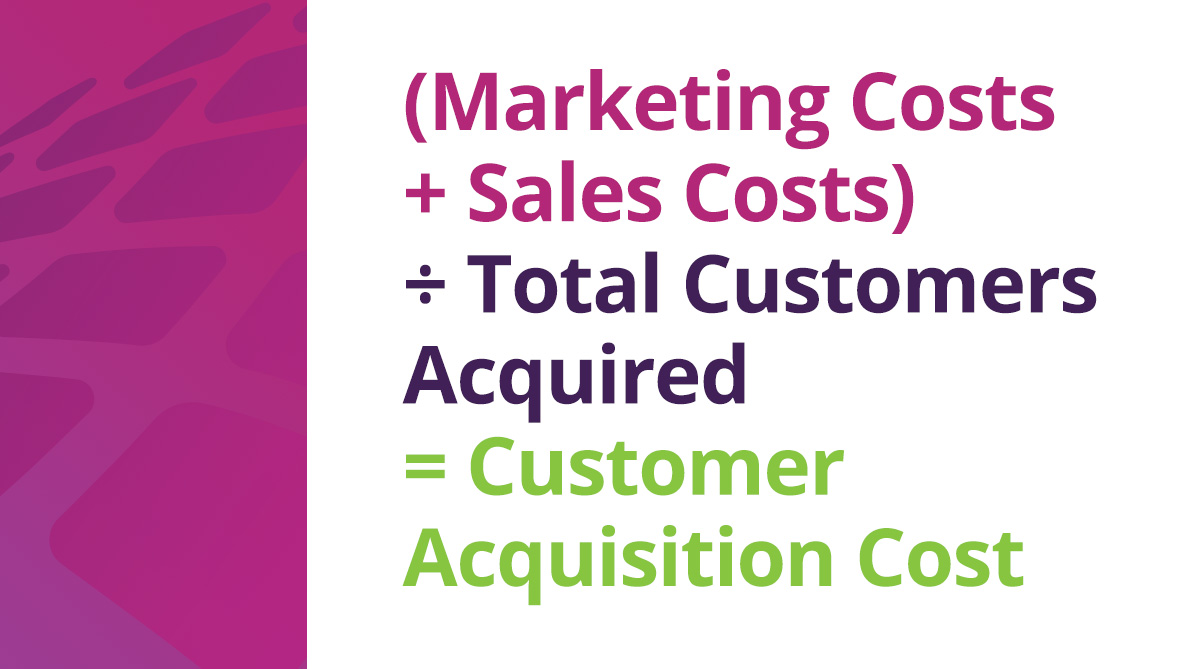
Calculate customer acquisition cost by adding the marketing and sales costs connected to a specific campaign or time period and dividing that by the number of customers acquired from that campaign or time period.
The basic CAC formula is MC + SC / AC = CAC, where:
- MC is marketing costs
- SC is sales costs
- AC is acquired customers
- CAC is customer acquisition cost
If a company spent $50K on sales and marketing, and gained 500 new customers, their customer acquisition cost would be $100, for example.
Identify acquisition channels
After your ideal target audiences have been defined, conduct research to understand where they consume media and how they prefer to buy. Before you add a new acquisition channel to your marketing and sales mix, also analyze the current channels you use to obtain customers. Combine your past successes with your new insights to determine the best channels to reach, nurture, and engage prospective buyers. Some common acquisition channels are:
- Social media channels: According to Hubspot, 28% of businesses are using social media in their marketing and sales efforts. Facebook, Instagram, LinkedIn, and Snapchat are all social media channels that many businesses are leveraging to reach prospective buyers.
- Influencer marketing channels: Influencers are people with large social followings within a particular industry or vertical. While this channel can be more costly than others, when leveraged correctly, influencers campaigns can be very successful.
- Paid advertising: Paid advertising channels can range from digital ads (Google AdWords, Facebook, LinkedIn, etc.), to TV and radio spots. They can be effective tools to obtain new customers quickly. However, you’ll want to ensure you’re choosing the best channels for your budget by keeping track of ROI and optimizing spend based on performance.
- Cold email or cold calling: Before cold outreach, first ensure that your team is reaching out to potential buyers, and not people who will never purchase. Not only will reaching out to the wrong people waste time and resources, but it could also hurt your business’s reputation.
Collect prospect data
A recent Forrester Consulting study uncovered that 64% of marketers want better prospecting data. Prospect data can be collected from a variety of sources including:
- Company website
- Online surveys
- Outreach channels (email, phone, social media)
- Returning customer’s purchase history

Solidify the human connection
The rise of technology has hindered sales’ abilities to have good old fashioned conversations with prospective customers. People are bombarded with digital advertising on a daily basis. In fact, the average American sees roughly 4,000 to 10,000 ads every day. With the constant digital noise, now more than ever people are yearning for real, human interactions. Create an emotional connection with prospects from the get-go. Build solid relationships by prioritizing face-to-face sales and personalization tactics.
Increase prospect engagement rates
Nothing can be more frustrating to a marketing or sales professional than lead streams going cold. Just because a channel used to work, doesn’t mean it always will. Use your CRM data to regularly analyze performance by channel. From there, optimize and invest more resources into the channels that keep prospects the most engaged.
Invest in a sales outsourcing partner
Outsourcing your sales function to a trusted third-party sales team can boost customer acquisition efforts, drive growth, and increase scale. An outsourced partner allows you to increase or decrease your sales investment based on generated campaign performance. The right partner will also:
- Understand your ideal customer
- Adhere to your specific brand guidelines
- Clearly communicate your value propositions, product details, pricing structure and more
- Track the KPIs of previous efforts and optimize based on results generated
- Use industry trends to build campaigns

Focus on Customer Retention
Do you know that a 5% increase in customer retention rates can boost profits by 25-95%? It’s also more cost-effective to keep a current customer than it is to gain a new one. Here are a few strategies that have been proven to keep customer satisfaction high, and churn rates low:
- Customer onboarding and training programs
- Personalization efforts
- Customer feedback tools
- Robust customer service teams
- Customer satisfaction surveys
- Using feedback to adjust processes
Increase Customer Lifetime Value (CLV)
CLV is the total value a customer brings to the business over a specific period of time. Acquisition costs should never exceed the customer’s lifetime value. For example, if the average CLV of a sporting goods shop is $200 but it costs more than $300 in advertising, marketing, and sales costs to bring on a new customer, the shop will lose money. Remember, it is typically more cost-effective to keep a current customer than it is to acquire a new one. Increasing the value of existing customers is an excellent growth strategy.
Section 6: Building a Successful Sales Team

Have you ever heard the saying, “A chain is only as strong as its weakest link?” One bad hire can cost your business thousands of dollars, but a successful team can accelerate growth and increase profits. Building a successful team starts during the recruitment process and should continue well after an employee has been onboarded. Here are a few tips to guide the sales hiring process.
Step 1: Create Team Member Personas
Recruiting the right sales candidates is a complex process and hiring the wrong person can hinder sales growth, damage your reputation, and hurt profit margins. Building team member personas will enable you to determine if a candidate is the right candidate for the job. Start by interviewing internal stakeholders and team members to see what skills and educational qualifications are necessary for a particular role.
When searching for the right sales reps to join your team, you’ll generally want to look for candidates who have these traits:
- Empathy
- Impeccable Communication Skills
- Self-awareness
- Assertiveness

Step 2: Nail the Recruitment Process
Generating demand for open positions can be challenging and costly. In fact, according to Forbes Magazine, on average companies spend over $3,300 per hire. In addition, many hiring managers are tasked with the responsibility to bring on new employees that can immediately prove their value.
Collaborating with HR to establish a rigorous vetting process will help your team narrow down candidate pools to salespeople who match your specific criteria. Since salespeople often work with team members in marketing, customer success, and finance, very qualified candidate should have multiple interviews with team members from across the organization. Lastly always define clear expectations for the role and make sure candidates are aware of them before extending a job offer.

Step 3: Determine the Right Compensation
A vital aspect of any sales plan is determining a compensation and commission structure for salespeople. Sales commission is typically variable based on sales performance while compensation is fixed. The right compensation and commission package will attract top talent and incentivize sales reps to reach or exceed their performance targets.
Step 4: Develop Onboarding, Training, and Mentorship Programs
Investing in onboarding, training, and mentorship programs will build employee trust while improving team performance. Sales reps want to work for companies that are invested in their career growth and development. Implement strong onboarding, training, and mentorship programs to increase team-wide transparency, improve skill sets, and promote employee’s career development.
Onboarding programs: Training Industry Magazine projected that it takes more than a year for newly hired salesperson to match the “same performance level as tenured sales reps.” Employee onboarding programs lay the foundation for an employee’s success with a company. It will also help new employees get ramped up faster.
.
Training programs: Training should be an ongoing process throughout the lifetime of an employee. Coaching and training programs are extremely vital to ensuring team members have the right skills sets and tools for success. In fact, according to CSO Insights, sales professionals who undergo training programs have 10% higher close rates. Coaching programs come in a variety of shapes in sizes but are ultimately designed to help sales representatives to hit their KPIs and increase company-wide conversion rates. They also help every team member stay up to date with sales strategy and process.
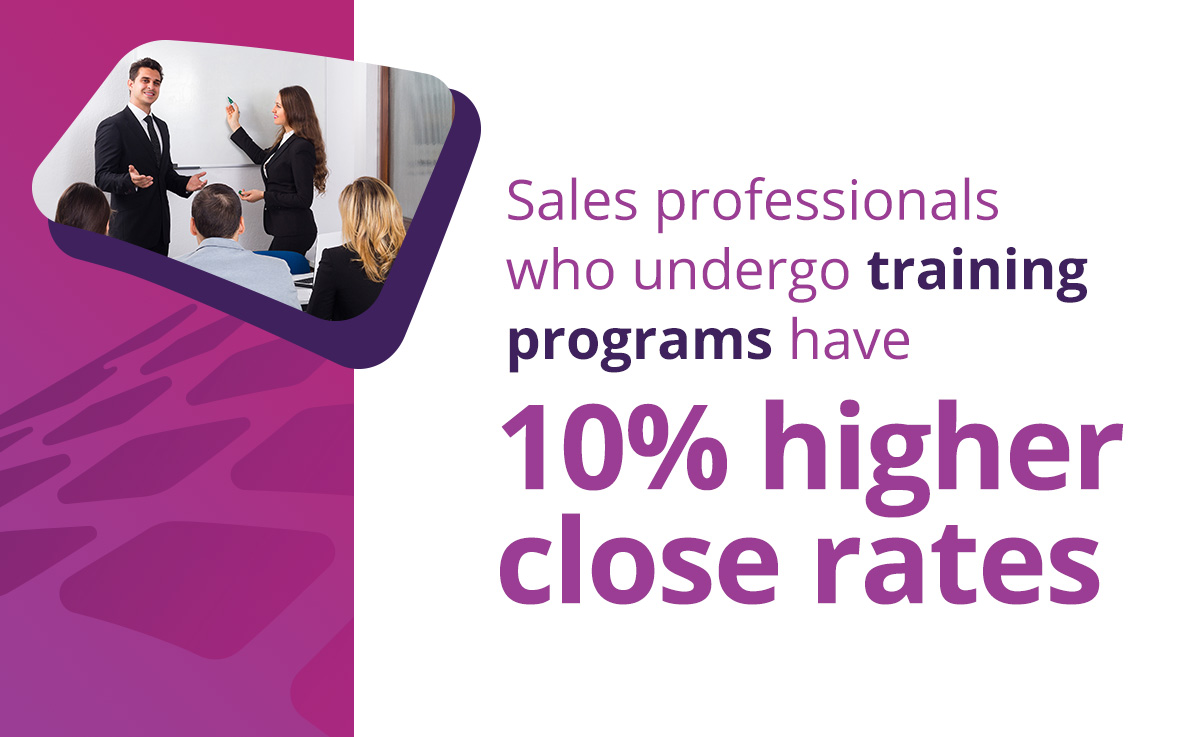
Mentorship Programs: Warren Buffett, Colin Powell, Cal Ripken Jr., and even Oprah have given recognition to their mentors for guiding them on their path to success. In fact, a study by the American Society for Training and Development revealed that 75% of executives acknowledge their mentors for helping them reach their current positions. A mentorship program will help younger team members develop skills and prepare employees for leadership roles within your company.
Step 5: Analyze Sales Reps Performance
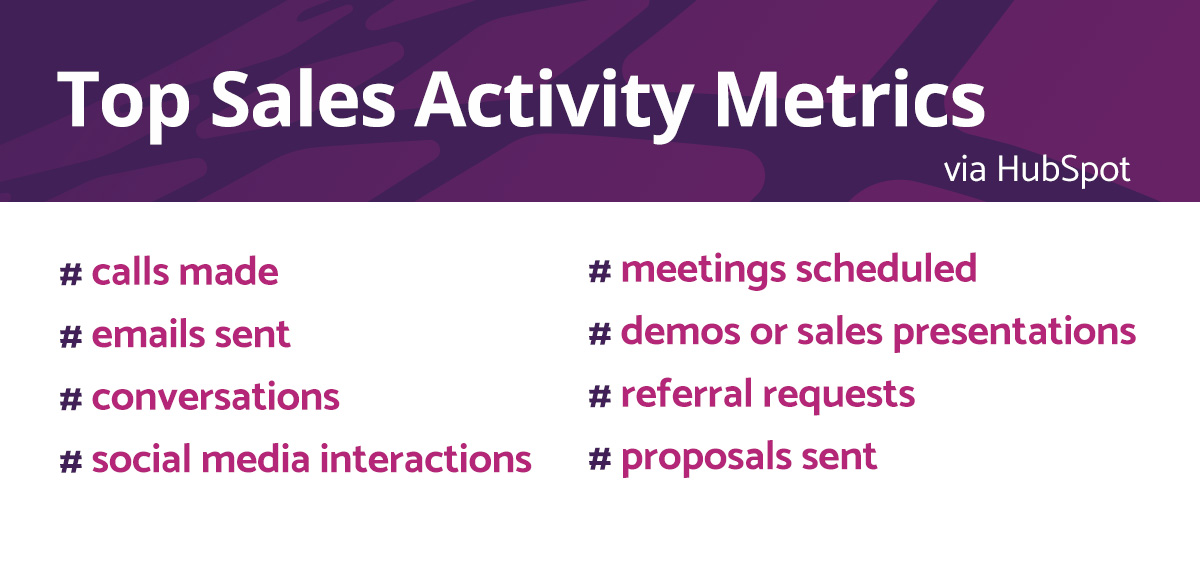
Analyze individual and team performance by tracking reps activity and performance metrics. Activity metrics can be used by sales managers to identify early pipeline issues, dissect why sales reps didn’t reach their sales goals, and refine touchpoints to increase conversion rates.
Among the most common sales metrics worth tracking are:
- Calls made
- Emails sent
- Conversations
- Social media interactions
- Meetings scheduled
- Demos or sales presentations completed
- Referral requests
- Proposals sent
Section 7: The Importance of Human Connection in Sales

Humans are wired to make connections with others. In fact, humans “need to connect is as fundamental as our need for food and water” according to the book, Social, by author Matthew Lieberman.
In our ever growing digital landscape, generating powerful connections with prospects will set your company apart from the competition. It’s no secret that the proliferation of technology has changed the way we interact with our colleagues, receive information, and engage with brands. The modern consumer is more digitally focused, and when it comes to sales outreach, they expect personalized and relationship-based approaches.
Sales strategies are constantly evolving. While new technologies may change the methods sales pros use to interact with prospects and customers, the focus will always be on building personal connections with prospects, customers, and clients. Including relationship selling tactics into sales outreach will help avoid making customers feel like they’re just another number. And the more engaged customers are with your brand, the more likely they are to purchase in the future. Therefore, it’s vital to build and leverage strong relationships with prospects and customers.

Here’s how to prioritize customer- and prospect-centric relationships in your sales strategy:
- Create powerful emotional bonds: Maya Angelou once said, “People won’t remember what you said or did; they will remember how you made them feel.” The moral of the story is how your customers feel during the buying process will affect whether or not they purchase from you in the future. Using emotion-based selling tactics will humanize your brand and help transform customers into brand advocates.
- Understand people’s needs: When out in the field, sales reps should practice active listening to understand prospects’ needs and find common grounds. Making a genuine effort to help customers achieve their goals.
- Take care with your communications Document and create an outreach workflow that sales team members can use from initial phone calls to email follow-ups. Take care not to inundate prospects with sales touchpoints. And personalize all your communications.
- Develop customer trust: Nowadays, people are more likely to trust friends, family, coworkers, and third-party review sites than salespeople. If a prospect doesn’t trust you, they likely won’t purchase. Building trust will increase customer loyalty and encourage repeat purchases.
Section 8: Why Face-to-Face Sales Is Still Important

Face-to-face sales is when a business uses face-to-face selling tactics to sell its products or services directly to the customer. In-person selling helps to drive better relationships between sellers and buyers. A face-to-face sales rep may:
- Promote products or solutions at a booth inside or outside of a brick and mortar retail store
- Book one-on-one meetings
- Go on door-to-door sales calls
- Attend trade shows, conventions, and industry events
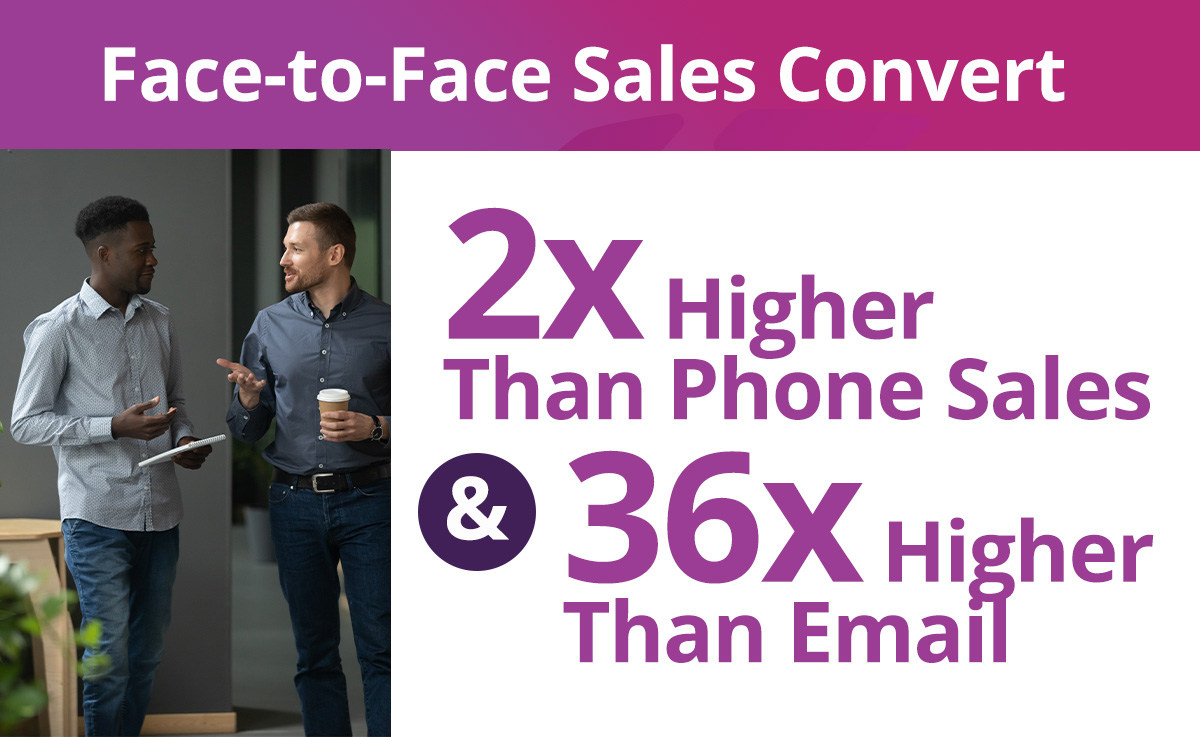
At Ascenta we believe that most sales strategies should include face-to-face selling. We’ve mobilized face-to-face sales teams across the country for some of the world’s largest organizations. We’re acutely aware that deploying an in-person approach to selling enables decision-makers to emotionally connect with a brand and understand its brand values. Here are some benefits we’ve learned along the way.

Put a face to your brand: Face-to-face sales interactions are often the first time a potential customer has contact with your brand, products, and services. Friendly, person to person connection humanizes the brand experience.
Identify with people’s values: Shared beliefs authenticate your brand and provide a ground floor for driving human connections. In fact, 64% of people said one of the main reasons they have a relationship with a brand is because of their shared values. Face-to-face selling provides a bridge to communicate your brand’s values directly with prospects and customers.
Educate prospects and customers: Face-to-face sales gives you a platform to engage directly with consumers and answer their questions about your products or services. Sales representatives in the field should be armed with a wide breadth of knowledge, not only about your products and services, but also about your industry in its entirety.
Demonstrate complicated products or services: Prospects are much more likely to purchase after seeing, testing or tasting a product. Brick and mortar retailers have mastered this by handing out free samples in store. Taking the time to demonstrate your product gives prospects the opportunity to learn how it will work best for them. The key is demonstrating how your product helps solve their pain points, needs, and desires.
Eliminate technical difficulties and miscommunication: A dropped call is enough to ruin any sale. Face-to-face selling eliminates these technical difficulties, enabling sales professionals to establish a rapport with prospects. You’ll also be able to use body language indicators to better gauge prospects’ reactions.
Face-to-face selling can be challenging. However, the benefits outweigh the investment that goes into training and mobilizing a face-to-face team. Engaging with your customers in an intimate setting is a completely different experience than nurturing customers online. Face-to-face sales allow you to understand prospects and customers in real-time, increase sales and create long-lasting, personal connections.
Section 9: Sales Lessons from Successful Companies

Every company starts on the ground floor. Some are successful and scale into massive enterprises, and others are not so lucky. We’ve analyzed the sales tactics that top companies use and comprised a list of the top lessons you should use to grow your brand.
Lead with your ‘why’
Author, Simon Sinek popularized the phrase, “People don’t buy what you do; they buy why you do it.” The most effective salespeople use emotion-based selling tactics to win business. And these tactics are more impactful when a sales pitch begins with ‘why,’ not ‘what.’ A great example of this is Apple. Apple doesn’t sell computers and phones. Instead they sell a lifestyle made easier through their products.
People don’t buy what you do; they buy why you do it.
~Simon Sinek
Hire good people
An underperforming employee could negatively impact morale, decrease sales revenue, and cost your business thousands. During the hiring process, search for candidates who are empathetic, kind, and knowledgeable. It’s also a good sign if a potential hire shows interest in career longevity with your company.
Data-driven mindset
Companies like Facebook, Hello Fresh, and FabFitFun use data to make more informed business decisions. Facebook is well known for using data to drive its product forward. In fact, on any given day, Facebook will run upwards of 10,000 versions of their social media network to measure the user experience. And while every company might not have the capacity to run thousands of tests per day, Facebook’s main lesson is: Having a data-driven mindset will enable your company to run more impactful marketing campaigns and build products or services customers love.
Use storytelling
Humans have been telling stories for thousands of years using a variety of media. What started as cave paintings 40,000 years ago has transformed into books, TV shows, podcasts, movies, magazines, and more. Storytelling is an effective sales method your sales teams in the field should be employing to win customers. In fact, humans are even biologically wired to consume information via stories. According to Jennifer Aaker, a Stanford Graduate School of Business professor,
Research shows our brains are not hard-wired to understand logic or retain facts for very long. Our brains are wired to understand and retain stories. A story is a journey that moves the listener, and when the listener goes on that journey they feel different. The result is persuasion and sometimes action.
~Jennifer Aaker
Effective storytelling will help you create more memorable prospect and customer experiences.
Boost your sales strategy with the right partner
Ascenta has helped companies, large and small, scale their sales strategies, acquire more customers, and increase customer lifetime values. Contact us today to learn how we can create face-to-face sales programs that build customer relationships and generate more revenue.
